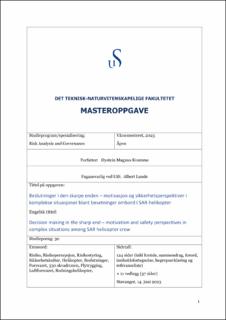| dc.description.abstract | Ever since its establishment in 1973, the helicopter rescue services has contributed to countless rescues. Rescue missions often receive a lot of attention in the media, and often we can see images from the media where the rescue teams apparently take great risks saving those who need help. Pictures of spectacular operations in mountain walls and from ships in distress at sea bring stories of both fatal accidents, but also successful operations where good efforts of professional rescue workers help to save lives that have been in great danger. The service is constantly changing, with the introduction of the AW101 SAR Queen as the replacement for the Sea King, and we see that the Norwegian rescue helicopter services is becoming increasingly integrated in the cooperation between state and municipal actors, private companies and voluntary organizations that together form the national rescue service.
The purpose of this assignment was to take a closer look at how risk was perceived and managed by crew members within an industry that is considered to maintain a high standard of safety work. The author has had the impression that the risk management models that exists within the Air Force are not adapted to the rescue missions and that these do not reflect how the crew is doing decisions and risk assessments.
The project used a Mixed Methods Approach including a pre-study consisting of a qualitative part which has collected data from a total of 5 crew members for the preparation of a questionnaire, and a quantitative part which consists of a survey including all crew members within the 330 Squadron. A total of 40 responses of the questionnaire were received. The selection consisted of crew members who had completed a minimum of 7 operational duty days in the past 12 months. The total response rate among the squadron's 330 crews and doctors was 27.5%. Overall, this gave a margin of error of +/- 13.2% in a confidence interval of 95%.
Based on empirical data, it can be stated that the 330 squadron carries out its missions both with a strong commitment in relation to assignment resolution, and with a continuous focus on how the missions are to be resolved in a safe and secure manner. Risk awareness and understanding of risk is high. Therefore, "Mission First, Safety Always" is a term that fits well with the Rescue Helicopter Service.
Based on the findings in the thesis, it is still worth looking at how risk assessments are carried out and documented, as this is done differently to what the Air Force procedures for Operational Risk Management (ORM) assumes. The investigation also shows that ORM is not necessarily adapted to and organized for everyday operational readiness, and that it may be necessary for the Air Force to implement provisions and procedures that are better suited to 330 Squadron's everyday life.
Also, in a safety perspective, 330 squadron may gain by better systematizing the sharing of experiences in a knowledge and learning perspective, with a view to transferring from individual to organizational learning, and by looking more closely at how support personnel in the department are involved to better optimize the service. | |
